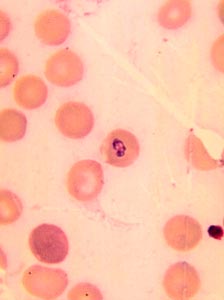|



|
|
Babesiosis  Babesiosis is a tick-borne disease caused by malaria-like parasites of the genus Babesia. These single-celled organisms invade red blood cells and may cause fatigue, aches, fever, chills, sweating, dark urine, enlarged spleen, or anemia. Infections can range from no serious symptoms to fatal disease. Tracking Babesia infections is difficult due to the number of asymptomatic infections. Babesiosis is a tick-borne disease caused by malaria-like parasites of the genus Babesia. These single-celled organisms invade red blood cells and may cause fatigue, aches, fever, chills, sweating, dark urine, enlarged spleen, or anemia. Infections can range from no serious symptoms to fatal disease. Tracking Babesia infections is difficult due to the number of asymptomatic infections.
First reported as "Texas cattle fever" around the turn of the century, babesiosis has come under increasing concern because the parasite can be transmitted to humans by the same tick that transmits the Lyme disease and ehrlichiosis bacteria. Studies have shown that a single tick can simultaneously carry all three microbes, creating the potential for passing multiple infections to people. Babesiosis can also be transmitted by blood transfusion.
Babesiosis can be treated with antiparasitic drugs; transfusions are sometimes used to treat severe cases. No vaccine is available.
NIAID Research
Vaccine ResearchWendy Brown, M.P.H., Ph.D., an NIAID-funded researcher at Washington State University's College of Veterinary Medicine, seeks to find proteins from the parasite Babesia bovis that elicit a protective immune response in cattle. Her studies aim to help define the elements of immunity to Babesia -related parasites.
DiagnosisRaymond Houghton, from Corixa Corporation, has received an NIAID grant to develop an antibody-based test to detect Babesia in the blood. The assay will supplement the existing Lyme disease test and ultimately will be used to test blood donors. Andrew Levin, of Immunetics, Inc., is developing a panel test to simultaneously test for multiple tick-borne diseases including babesiosis, Lyme disease, ehrlichiosis, and Rocky Mountain spotted fever.
Additional links:CDC information on babesiosis
Latest News |
News Releases | Publications
NIAID Home | Search
NIAID
Last updated August 29, 2001
|